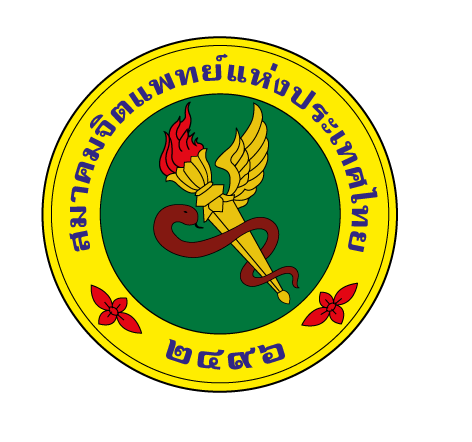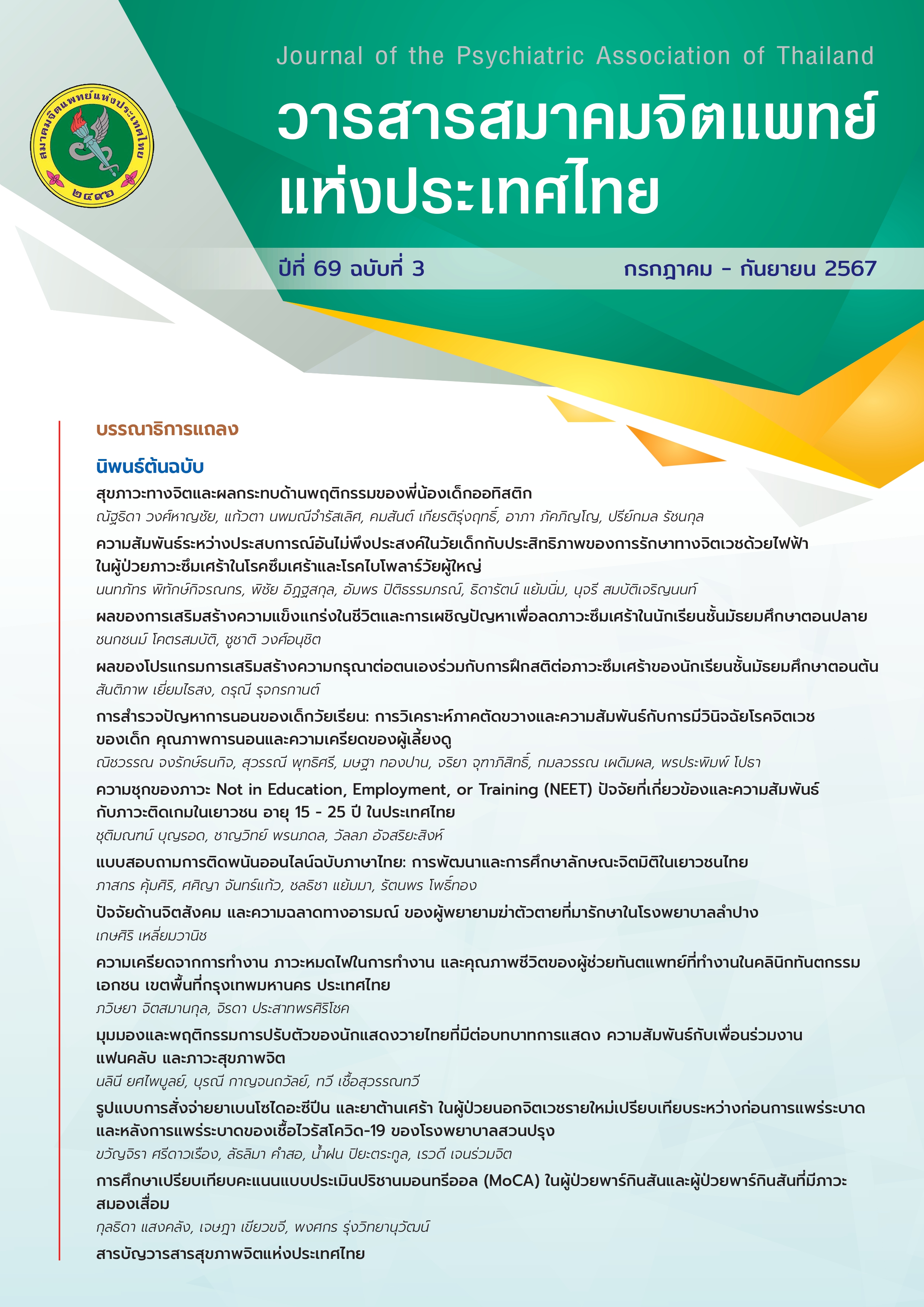รูปแบบการสั่งจ่ายยาเบนโซไดอะซีปีน และยาต้านเศร้า ในผู้ป่วยนอกจิตเวชรายใหม่เปรียบเทียบระหว่างก่อนการแพร่ระบาดและหลังการแพร่ระบาดของเชื้อไวรัสโควิด-19 ของโรงพยาบาลสวนปรุง
Main Article Content
บทคัดย่อ
วัตถุประสงค์ เพื่อเปรียบเทียบรูปแบบการสั่งจ่ายยาเบนโซไดอะซีปีน และยาต้านเศร้า ในผู้ป่วยนอกจิตเวชรายใหม่ของโรงพยาบาลสวนปรุงระหว่างก่อนและหลังการแพร่ระบาดของเชื้อไวรัสโควิด-19 รวมถึงศึกษาถึงปัจจัยที่ส่งผลต่อรูปแบบการสั่งจ่ายยา
วิธีการศึกษา รูปแบบการศึกษาแบบย้อนหลัง (retrospective cohort study) โดยเก็บข้อมูลจากฐานข้อมูลอิเล็กทรอนิกส์และเวชระเบียนของผู้ป่วย ที่มีการบันทึกข้อมูลตั้งแต่เดือนมีนาคม พ.ศ. 2561 ถึงเดือนกุมภาพันธ์ พ.ศ. 2565 กลุ่มประชากรที่ศึกษา คือ ผู้ป่วยนอกจิตเวชรายใหม่ที่เข้ารับบริการ ณ โรงพยาบาลสวนปรุง วิเคราะห์ข้อมูลโดยใช้สถิติ logistic regression, independent t-test และ Fisher’s exact test
ผลการศึกษา ผู้ป่วยจำนวน 15,596 คน แบ่งเป็นก่อนและหลังการแพร่ระบาดของเชื้อไวรัสโควิด-19 จำนวน 8,663 คน และ 6,933 ตามลำดับ พบว่าความชุกของการสั่งจ่ายยาเบนโซไดอะซีปีน และ/หรือ ยาต้านเศร้า ในช่วงหลังการแพร่ระบาดของเชื้อไวรัสโควิด-19 เพิ่มขึ้นกว่าช่วงก่อนการแพร่ระบาดของเชื้อไวรัสโควิด-19 เป็น 1.15 เท่า อย่างมีนัยสำคัญทางสถิติ (95%CI 1.03-1.29, P=0.010) เมื่อปรับค่าที่ได้ด้วยปัจจัยที่มีผลพบว่า ความชุกของการสั่งจ่ายยาเบนโซไดอะซีปีนเพิ่มขึ้นเป็น 1.21 เท่าอย่างมีนัยสำคัญทางสถิติ (95%CI 1.12-1.30, P<0.001) และความชุกของการสั่งจ่ายยาต้านเศร้า เพิ่มขึ้นเป็นเป็น 1.04 เท่า แต่ไม่มีนัยสำคัญทางสถิติ (95%CI 0.95-1.13, P=0.397) ขนาดยาที่ได้รับต่อวันพบว่าลดลงเมื่อเทียบกับในช่วงก่อนการแพร่ระบาดของเชื้อไวรัสโควิด-19 อย่างมีนัยสำคัญสถิติ (P<0.05)
สรุป การสั่งจ่ายยาเบนโซไดอะซีปีน และ/หรือ ยาต้านเศร้า ในช่วงหลังการแพร่ระบาดของเชื้อไวรัสโควิด-19 มีความชุกเพิ่มขึ้นเมื่อเทียบกับช่วงก่อนการแพร่ระบาด โดยเฉพาะความชุกของการสั่งจ่ายยาเบนโซไดอะซีปีน ซึ่งอาจเป็นผลมาจากสัดส่วนของจำนวนผู้ป่วยที่ถูกวินิจฉัยโรควิตกกังวลเพิ่มขึ้นหลังสถานการณ์แพร่ระบาดของเชื้อไวรัสโควิด-19 อย่างไรก็ตามพบว่าขนาดยาที่ได้รับต่อวันในช่วงหลังการแพร่ระบาดของเชื้อไวรัสโควิด-19 ลดลง โดยข้อมูลรูปแบบการสั่งจ่ายยาเหล่านี้จะช่วยในการวางแผนระบบยาในโรงพยาบาลจิตเวชเพื่อรองรับความต้องการของผู้มารับบริการและการบริบาลเภสัชกรรมในกรณีเกิดสถานการณ์แพร่ระบาดของโรคต่อไป
Article Details

This work is licensed under a Creative Commons Attribution-NonCommercial-NoDerivatives 4.0 International License.
บทความที่ส่งมาเพื่อพิจารณา ต้องไม่เคยตีพิมพ์หรือได้รับการตอบรับให้ตีพิมพ์ในวารสารฉบับอื่น และต้องไม่อยู่ระหว่างการส่งไปพิจารณาในวารสารอื่น
References
da Rosa Mesquita R, Francelino Silva Junior LC, Santos Santana FM, Farias de Oliveira T, Campos Alcântara R, Monteiro Arnozo G, et al. Clinical manifestations of COVID-19 in the general population: systematic review. Wien Klin Wochenschr 2021;133(7-8):377-82.
Bertini CD Jr, Khawaja F, Sheshadri A. Coronavirus disease-2019 in the immunocompromised host. Clin Chest Med 2023;44(2):395-406.
Koçak O, Koçak Ö E, Younis MZ. The psychological consequences of COVID-19 fear and the moderator effects of individuals' underlying illness and witnessing Infected friends and family. Int J Environ Res Public Health 2021;18(4).
Corpuz JCG. Adapting to the culture of ‘new normal’: an emerging response to COVID-19. J Public Health 2021;43(2):e344-e5.
Antipova A. Analysis of the COVID-19 impacts on employment and unemployment across the multi-dimensional social disadvantaged areas. Soc Sci Humanit Open 2021;4(1):100224.
Xiong J, Lipsitz O, Nasri F, Lui LMW, Gill H, Phan L, et al. Impact of COVID-19 pandemic on mental health in the general population: a systematic review. J Affect Disord 2020;277:55-64.
Salari N, Hosseinian-Far A, Jalali R, Vaisi-Raygani A, Rasoulpoor S, Mohammadi M, et al. Prevalence of stress, anxiety, depression among the general population during the COVID-19 pandemic: a systematic review and meta-analysis. Global Health 2020;16(1):57.
Campitelli MA, Bronskill SE, Maclagan LC, Harris DA, Cotton CA, Tadrous M, et al. Comparison of medication prescribing before and after the COVID-19 pandemic among nursing home residents in Ontario, Canada. JAMA Netw Open 2021;4(8):e2118441.
Metin A, Erbiçer ES, Şen S, Çetinkaya A. Gender and COVID-19 related fear and anxiety: a meta-analysis. J Affect Disord 2022;310:384-95.
Uthayakumar S, Tadrous M, Vigod SN, Kitchen SA, Gomes T. The effects of COVID-19 on the dispensing rates of antidepressants and benzodiazepines in Canada. Depress Anxiety 2022;39(2):156-62.
Bandelow B, Zohar J, Hollander E, Kasper S, Möller HJ, Zohar J, et al. World federation of societies of biological psychiatry (WFSBP) guidelines for the pharmacological treatment of anxiety, obsessive-compulsive and post-traumatic stress disorders - first revision. World J Biol Psychiatry 2008;9(4):248-312.
Department of Mental Health, Ministry of Public Health, Thailand. Clinical practice guideline of major depressive disorder for general practitioner: CPG-MDD-GP. Bangkok: Department of Mental Health; 2010.
Preskorn SH, Borges-Gonzalez S, Flockhart D. Clinically relevant pharmacology of neuropsychiatric drugs approved over the last three years: part II. J Psychiatr Pract 2006;12(5):312-6.
Mu A, Weinberg E, Moulin DE, Clarke H. Pharmacologic management of chronic neuropathic pain: review of the Canadian pain society consensus statement. Can Fam Physician 2017;63(11):844-52.
Susman J, Klee B. The role of high-potency benzodiazepines in the treatment of panic disorder. Prim Care Companion J Clin Psychiatry 2005;7(1):5-11.

